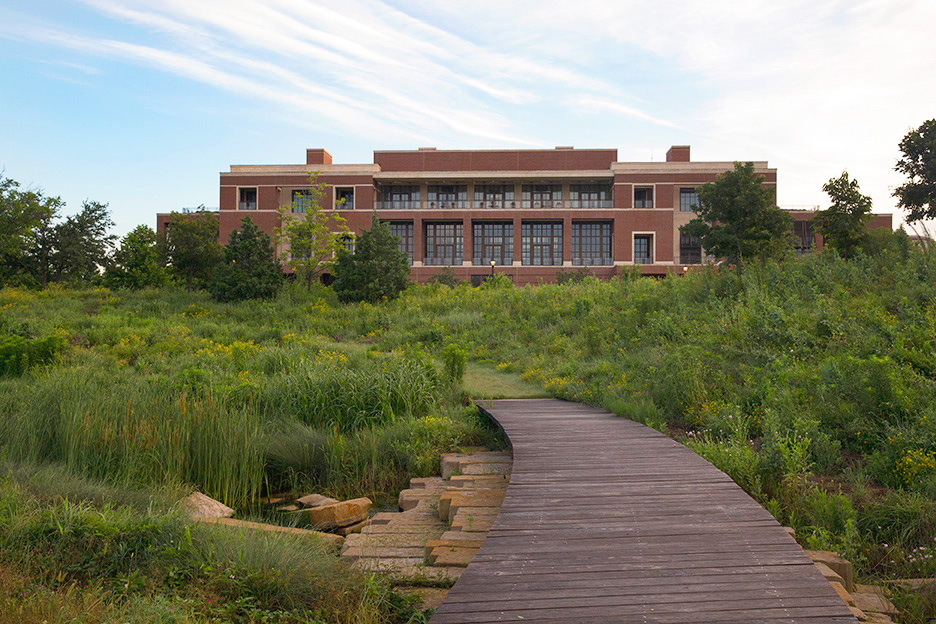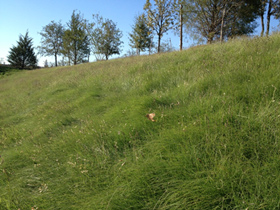Living Urban Legend

Native plants help connect visitors to historic North Texas vistas at the George W. Bush Presidential Center. PHOTO John W. Clark
WHEN FORMER FIRST LADY LAURA BUSH and her family chose a ranch in Crawford as a refuge during the White House years, restoring prairie on the 1,500-acre spread was a priority for the Texans. The new campus of the George W. Bush Presidential Center that opens in May not only includes trees from that ranch, but a landscape designed to display diverse native plants of the state to showcase their beauty – and teach lessons about their ability to handle Texas’ weather.
The Presidential Center’s location at Southern Methodist University’s campus in the heart of Dallas means that thousands of visitors annually will enjoy a glimpse into historic North Texas the landscapes provide. Lady Bird Johnson Wildflower Center staff with expertise in developing native landscapes supplied guidance on designing the campuses’ 23 acres to reap the benefits that native plant communities offer. Working as a consultant to Michael Van Valkenburgh Associates Inc., the Center’s Ecological Research and Design team suggested ways to use native wildflowers, native grasses and other state flora to provide a unique visitors experience.
The Wildflower Center staff drew on decades of designing and restoring landscapes as consultants for public and private projects based on their research on developing functional communities of native plants from the soils on up. “We are able to bring hard science to the discipline of landscape design in a way that few other organizations can,” says ecologist Mark Simmons, who directs the Ecological Research and Design department at the Wildflower Center that is part of The University of Texas at Austin.
This work helps sustain Lady Bird Johnson’s dream that Americans continue to enjoy a connection with nature’s splendor. Stretches of tall grass prairie, for instance, run throughout the southern portion of the landscape of the Presidential Center’s grounds, a reminder of an ecosystem nearly gone. Less than 1 percent of this blackland prairie still exists in its pristine form in the state.
Swaths of Texas bluebells, purple coneflower and other native wildflowers will bloom like colored ribbons in the sections of tall grass, mid-grass and wetland prairie as the campus develops. Besides drawing pollinators and other wildlife, the prairies, a wildflower meadow and other landscape features offer practical benefits. Healthy native plant communities help clean the air, filter pollutants out of storm water and improve a region’s environment in other ways, while often requiring less input to maintain.
The hundreds of native species in the Center’s prairies include big bluestem, little bluestem and Indian grasses. Compared to Bermudagrass and other traditional, non-native lawn grasses with their roots of a few feet at most, prairie grasses appear to be on steroids. Some have been found to extend 20 feet.
These deep roots make prairies better than forests as a green sink for lowering atmospheric levels of carbon dioxide, which they convert into root components. The deep roots also reduce soil erosion and watering needs, help filter pollutants and help prairies handle freezing temperatures and drought.
The Presidential Center grounds feature many drought-tolerant native plants, and incorporate structural elements that capture storm water on site. A parking lot just north of SMU Boulevard, for instance, includes depressions called bioswales between rows. These sunken gardens soak in rainwater and cleanse it rather than letting it run off into sewers. Bioswales and other water-capturing features developed with Wildflower Center input occur throughout the grounds, providing natural irrigation and feeding into a wet prairie. That prairie directs captured water into an underground cistern for redistribution.

Habiturf™, a native lawn mix developed by the Wildflower Center, is a major feature throughout the grounds and showcases the sustainable capabilities of native ecosystems. PHOTO Mark Simmons
A half-acre Great Lawn of five native turf grasses also serves as an overlook on the south lawn, along SMU Boulevard and in many other spots. Emily Manderson, a Wildflower Center senior environmental designer, notes that performance of the native lawn during a mock up before installation was so impressive that the native turfgrass lawn areas were expanded to cover 9 acres on site.
Wildflower Center research has shown that this mixture of native turf grasses called Habiturf™ can form a denser carpet than non-native turfs such as Bermudagrass. The mixture also grows slower and needs less mowing than traditional lawns and is less water-dependent than commonly-used St. Augustine. Habiturf also has the advantage of going dormant and brown during water restrictions or a drought – and springing back quickly when conditions improve.
“The Bush Presidential Center landscape will go through cycles and help change expectations of what a landscape should look like,” Manderson notes. “Even when it doesn’t look like a traditional lawn or as if it’s thriving, the complexity of the system means there is activity going on because it’s based on functional ecosystems.”

